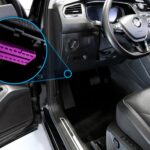The OBD2 port in your 2018 Hyundai Elantra GT Sport is your gateway to diagnosing and modifying your vehicle’s performance. Knowing its location and understanding its function is crucial for any car enthusiast or DIY mechanic. This guide provides a detailed overview of the OBD2 port in the 2018 Hyundai Elantra GT Sport, including its location, functionality, and potential uses.
Understanding the OBD2 Port
OBD2, or On-Board Diagnostics II, is a standardized system that allows external devices to communicate with your car’s computer. The OBD2 port, a 16-pin connector, provides access to a wealth of data about your vehicle’s engine, transmission, emissions, and other crucial systems. Mechanics and car owners use this port for various tasks, including:
- Diagnostics: Reading and clearing diagnostic trouble codes (DTCs) to identify malfunctions.
- Performance Monitoring: Tracking real-time data such as engine speed, coolant temperature, and fuel efficiency.
- Tuning: Modifying engine parameters to enhance performance or fuel economy.
- Emissions Testing: Verifying compliance with emissions regulations.
Locating the OBD2 Port in Your 2018 Hyundai Elantra GT Sport
The OBD2 port in the 2018 Hyundai Elantra GT Sport is typically located under the driver’s side dashboard, near the steering column. More specifically, it’s often found:
- Above the foot pedals: Look for the connector towards the top of the footwell area.
- To the left of the steering column: It may be positioned slightly to the left of the steering wheel.
- Behind a small access panel: In some cases, the port might be hidden behind a removable panel.
Use a flashlight to illuminate the area and carefully inspect for the 16-pin trapezoidal connector.
Utilizing the OBD2 Port
Once you’ve located the OBD2 port, you can connect various devices, such as:
- OBD2 Scanners: These handheld devices read and clear DTCs, display live data, and sometimes offer advanced functionalities like data logging.
- Code Readers: Simpler devices primarily focused on reading and clearing DTCs.
- Tuning Devices: Used to modify the vehicle’s engine control unit (ECU) for performance enhancements.
Connecting to the OBD2 port opens a wide range of possibilities for understanding and managing your 2018 Hyundai Elantra GT Sport’s performance.
Beyond the Basics: Port Flashing
Advanced users can utilize the OBD2 port for “port flashing,” a process that allows rewriting the ECU’s software. This enables modifications like:
- Performance Tuning: Increasing horsepower and torque.
- Fuel Economy Tuning: Improving fuel efficiency.
- Custom Feature Activation: Enabling hidden features within the vehicle’s software.
However, port flashing should be performed with caution and by experienced individuals, as improper modifications can damage the ECU.
Conclusion
The OBD2 port in your 2018 Hyundai Elantra GT Sport is a powerful tool for diagnostics, maintenance, and performance enhancement. Knowing its location and understanding its functionality allows you to take control of your vehicle’s health and performance. Whether you’re a seasoned mechanic or a curious car owner, the OBD2 port is an invaluable resource. Remember to consult your vehicle’s owner’s manual for specific instructions and warnings related to OBD2 usage.
